Sourdough English Muffin Recipe
This post may contain affiliate links.
Sourdough English muffins are such a lovely little invention. They are tangy rounds of fermented dough with just enough nooks and crannies to hide butter and jam in.
And they are actually quite easy to make - you just have to be organised to give the dough enough time to ferment. This recipe uses an active and bubbly sourdough starter, however there is a variation for Sourdough Discard English Muffins further down.
English Muffins made with sourdough starter are fairly easy to put together. You basically mix the dough into a relatively smooth (yet sticky) dough and then leave it overnight to ferment.
If you have a bit more time, you can pop it in the fridge to ferment for up to 3 days. This little trick will ensure you don't over ferment the dough ... and you get that beautiful rounded sourdough tang that is so sought after with sourdough English muffins.
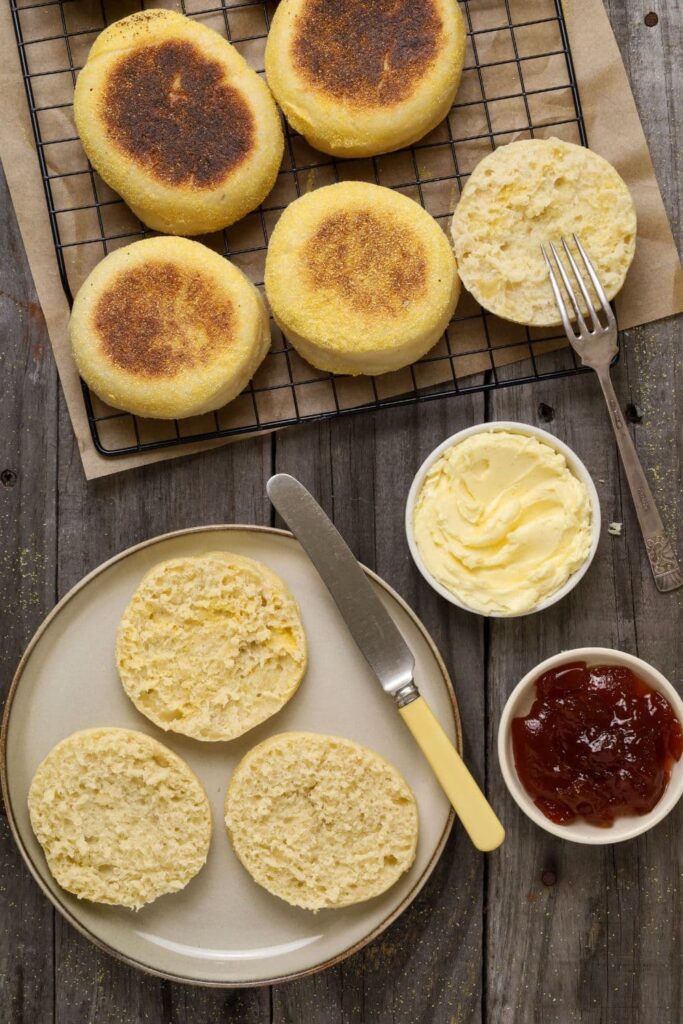
English Muffins Aren't Really English
Here's some trivia for you ... because I just love a bit of history. English muffins aren't actually English. In fact, they were invented in the US. And in England - they're called American muffins. Crazy right?
These crazy popular leavened muffins were actually invented by an Englishman in the US, New York City to be precise. If you're interested in more of the history of English Muffins, you can read all the info here.
How To Make Sourdough English Muffins
This sourdough English muffin recipe is quite simple. The process does take a few days due to the fermentation - but this is a good thing because your sourdough starter will make English muffins that are much easier to digest than store bought ones!
Ideally, you'll need an active sourdough starter, but discard will work (see notes on this further down). You might also like to turn this into a sourdough English muffin loaf.
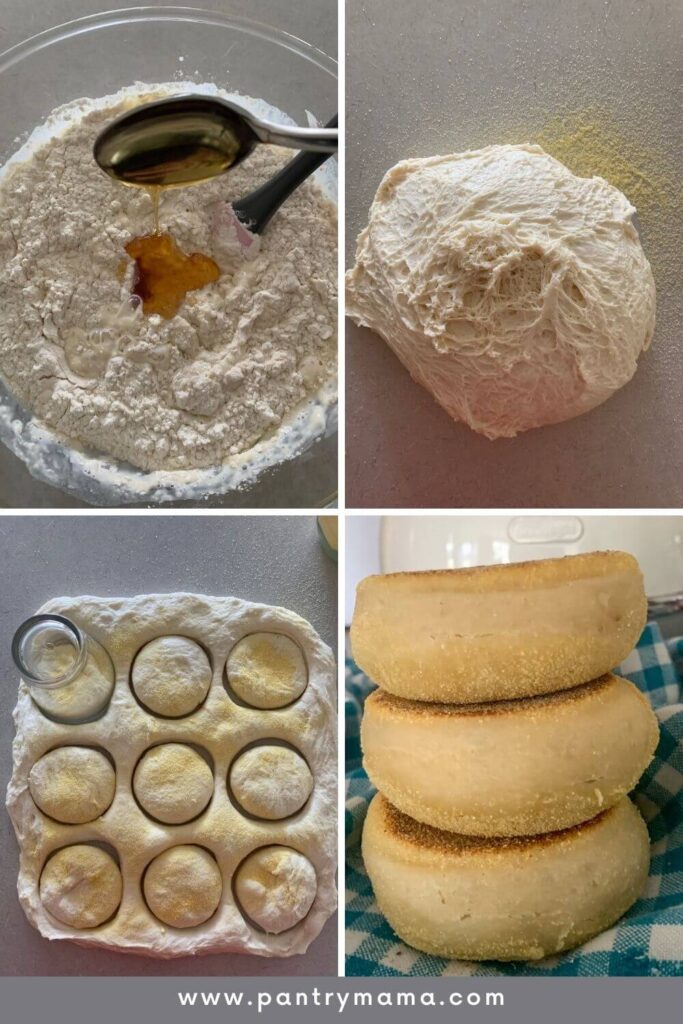
Here's the basic process for making English Muffins with a sourdough starter:
- Add flour, milk, honey, salt and sourdough starter to a large bowl and mix together to form a sticky dough.
- Use wet hands or a dough scraper to gently knead the dough in the bowl. It will be sticky because of the hydration level, but it will form a dough.
- Cover the bowl and leave it to ferment on the kitchen counter (overnight is ideal as long as it's not too warm). You'll find the mixture will double in size.
- Once the dough has fermented, work you way around the bowl and bring the dough into a ball using stretch and folds.
- Leave the dough to rest for around 30 minutes.
- Now sprinkle a generous amount of corn meal onto your kitchen counter and ease the dough out on top of this.
- Gently roll the dough out to form a rectangle (you can use your hands if you like).
- Use a scone or biscuit cutter to cut rounds of dough out. I used a small glass dipped in flour to stop it sticking.
- Place the rounds onto a parchment lined tray dusted with cornflour.
- Leave them to rise for around an hour (they should be puffy and light).
- Heat a skillet or frying pan and dust with corn meal.
- Place 4 English Muffins into the skillet at once and cover. Cook on medium heat for around 6 minutes before flipping them and cooking on the other side.
- Once they've cooled a little, split them and spread with butter and jam!
Stages of Fermentation for Sourdough English Muffins
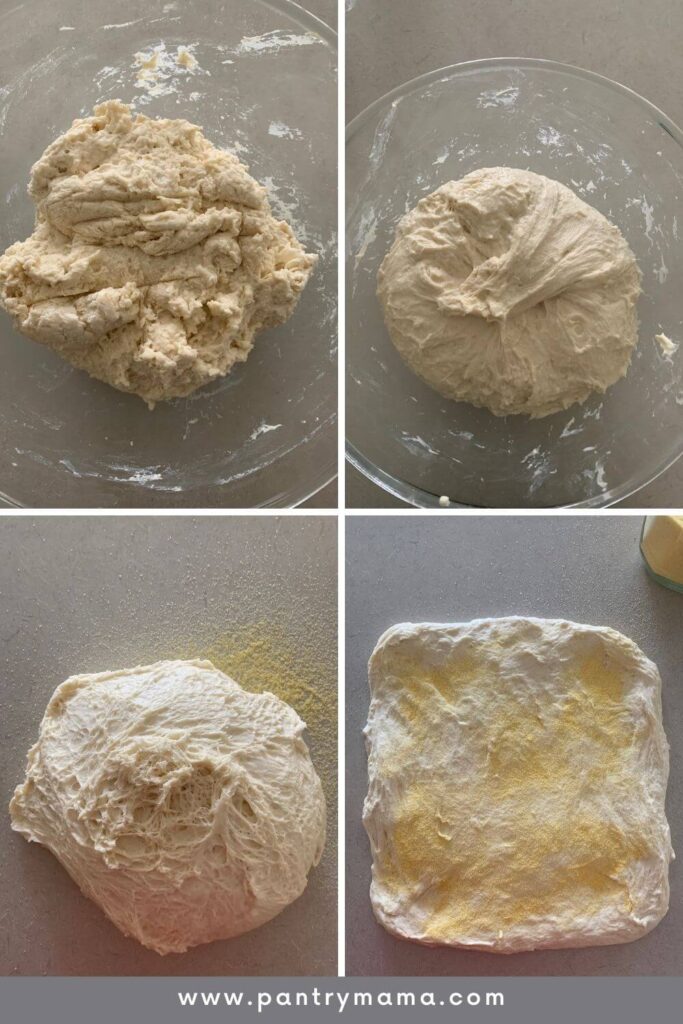
This image shows the dough when it's first mixed to how it looks when you've pulled it together into a ball after fermentation.
You can see that the dough has developed structure and smoothed out.
The bottom left shows the dough turned out onto the kitchen counter. You can see the beautiful gluten strands that have formed during fermentation.
The dough is still a little sticky at this stage, so corn meal is essential to keep it workable and if you have some cornmeal leftover, why not try these sourdough cornbread muffins.
If you are loving fermented breakfast treats, you might also like these overnight sourdough waffles.
The Secret To Good Sourdough English Muffins
Whether you're making sourdough English Muffins, or the regular variety - there's one thing that can make or bread a good muffin. You can't cut them!
Seriously, do not use a knife. To make sure you get maximum nooks and crannies, you need to split them with a fork.
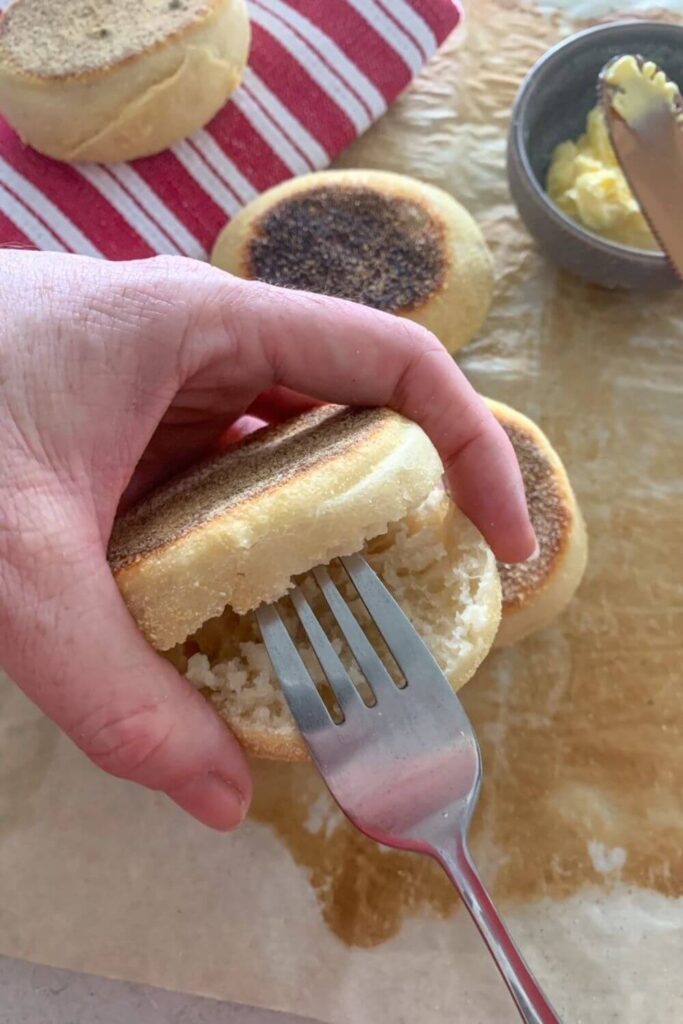
Once they're cool, push a fork into the side of the muffin and keep going around the edge until it splits open.
This is called "fork split" and will ensure that there are lots of "gnarly" bits of dough that go crispy and brown when toasted. Trust me, it's a game changer!
You must ensure that they have cooled though - if you do it when they're too hot, the steam trapped inside will cause a gummy crumb (just like when you cut sourdough bread too soon).
Patience really is a virtue with sourdough!
Additional Tips
I like to make my English Muffins with active, fed sourdough starter. But if you have lots of discard to use up, you can use the discard instead (as long as it's not too old, up to a week is ok).
If you want to use your discard in this recipe, just use it instead of active starter and add a half teaspoon of commercial yeast to your mixture.
This will ensure that the dough rises enough. This is especially important if you're still building your starter as your discard won't have enough of a yeast colony yet.
Still follow the instructions below, they will work.
You might just find that it rises a bit faster with the commercial yeast, so you won't need to leave them to rise for so long. They will also ferment in the fridge if you use commercial yeast.
If you have a mature starter, I would recommend trying this recipe without commercial yeast. Because of the long ferment time, you might be pleasantly surprised - even with your discard!
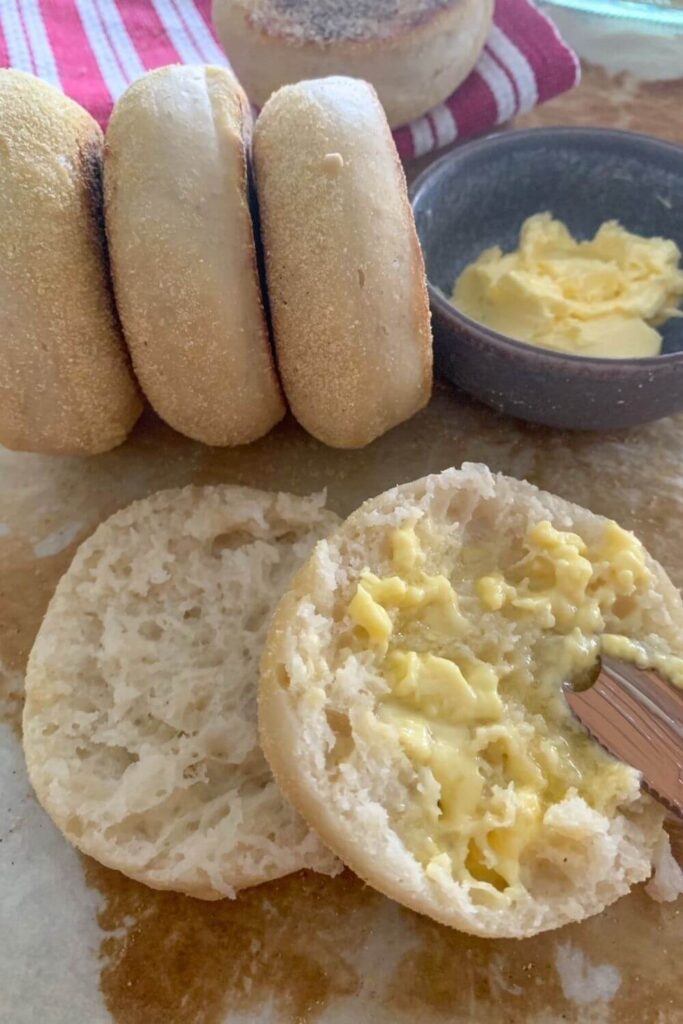
Making Sourdough English Muffins in Hot Weather
If the weather is warmer where you live, you might need to adjust things ever so slightly to ensure that you don't over ferment your dough.
It's not dissimilar to making traditional sourdough bread and making allowances for hotter temperatures.
Sourdough English Muffins are meant to be fermented for a longer period (it's what gives them the most amazing flavor), however if the ambient temperature in your home is over 28C you may need to use your refrigerator.
Once you've mixed the dough, allow it to ferment a little while on the kitchen counter - no more than an hour. Then place the dough into the fridge to ferment. It will take up to 3 days to fully ferment in the fridge.
If you do want to do an overnight ferment on the kitchen counter then you can reduce the amount of starter used. Drop it down to 100g of starter and use cold milk when you mix the dough.
These small tweaks will allow you to ferment the dough longer without over fermentation.
Serving Suggestions
There are lots of ways to enjoy these delicious sourdough English Muffins. While they are absolutely perfect toasted with lashings of butter, you might also enjoy some of these ideas:
- Toast and top with with homemade butter and sprinkle with cinnamon sugar. You might even like to serve them with this whipped honey cinnamon butter!
- Use them to make bacon and egg breakfast sandwiches. Don't forget the cheese! I love using this sourdough scrambled egg inside mine!
- Use them instead of burger buns for something different.
- Top with your favorite slices of cheese, fresh tomato and lashings of salt and pepper. This might just be one of my favorite lunches.
- Use them as mini pizza bases. My boys love making their own pizzas after school and these sourdough English muffins make it a breeze!
Notes & Substitutions
A few notes on ingredients and substitutions for sourdough English Muffins:
- You can use plain or all purpose flour instead of Bread or Baker's flour if you want to. But you may find that you need to reduce the amount of milk.
- If you have buttermilk on hand from making cultured butter or sweet cream butter, you can substitute some of the milk in this recipe with the buttermilk.
- You can use plain or all purpose flour to dust them with instead of corn meal, however you won't get the same cooked texture as you would with corn meal. Semolina is a better substitute than corn meal.
- You can keep the mixture for this sourdough English muffin recipe in the fridge for up to 3 days. Take it out of the fridge for around 30 minutes before you turn the dough out on the kitchen counter. Cut the rounds out and then let them rise before you cook them. It's better to cut them out with cooler dough and then let them warm up.
- Once you've cut them out, you can put the tray in the fridge for up to 24 hours. Let them come back to room temp before you cook them.
- Cooked English Muffins freeze really well. Store in ziploc bags and defrost and toast as you would like. For easy toasting, don't forget to fork split them before you freeze them.
If you're looking for another English inspired sourdough recipe, check out these sourdough crumpets.

Want More Recipes?
If you love this recipe, you might be interested in these ideas:
- Easy Sourdough Bagels
- Sourdough Hamburger Buns
- No Wait Sourdough Waffles
- Lemon Sourdough Muffins
- Apple & Cinnamon Sourdough Muffins

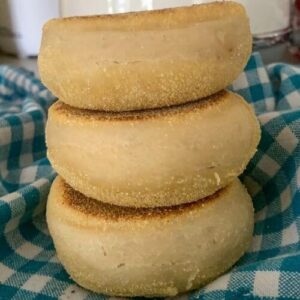
Sourdough English Muffins
Video
Equipment
- Mixing Bowl
- Cast Iron Skillet
- Biscuit Cutter
Ingredients
- 200 g Sourdough Starter fed and bubbly (reduce in warmer weather)
- 500 g Milk cold is better for overnight ferment
- 600 g Bread Flour
- 12 g Salt
- 20 g Honey you can use sugar if you want to
- 50 g Cornmeal for dusting
Instructions
- In a large glass bowl, mix together all of the ingredients, including your sourdough starter and bring it together to form a dough. The dough will be quite sticky. Gently knead the dough to bring it together.It's easy to do by hand in the bowl for less washing up, but if you prefer to do it in a stand mixer that's perfectly fine too.

- Once you have a dough formed, cover it in plastic wrap and set aside for around 12 hours to ferment at room temperature (see notes). You want the dough to rise (it doesn't need to double though). It should rise at least half in the bowl and become a smoother, structured dough (see the pics above of my dough). It's important that the dough maintains its gluten structure in order to be shaped into rounds.Just like traditional sourdough bread, you'll need to watch the dough, rather than the clock.

- Once you're happy with the dough, you can wet your hands and gently shape your dough into a rough ball by performing a set of stretch and folds. This will deflate the dough - but don't worry. Now leave the dough to rest for around 30 minutes.
- Dust your work surface with corn meal and then ease the dough out of the bowl. Sprinkle corn meal on the top of the dough too. Depending on how sticky your dough is, you might need to add some extra as you go along so keep it handy.

- Gently press the dough into a rectangle using your hands. Using a rolling pin, gently roll your dough to around ½ - ¾ inch thick. You don't want it too thick or your muffins will be doughy and take too long to cook in the middle. Using a biscuit cutter (or glass or plastic tumbler) gently cut out rounds of your dough and place them on a baking sheet lined with parchment paper and dusted with corn meal. Keep going until you can't cut any more. Then gather up the dough, roll it back out and repeat until you've used all the dough up.Cover the muffins with a tea towel and leave to rest for around 30 minutes.

- Heat a fry pan or skillet on the stove top. You want a medium heat - you don't want to burn the outside and leave the inside raw, so just keep an eye on them and adjust as you need to. Place 4 - 6 muffins in your skillet, cover with the lid and cook for around 6 minutes on each side. There is no need for oil or butter, the corn meal will protect them from sticking. Turn them over once you see the dough bubbling (they will be puffed up from the heat).Once they are golden on each side, take off the heat and allow to cool. Repeat the process until all of the muffins are cooked.

- Once they are cool, use a fork to split them and enjoy them with butter or toast them for extra golden goodness!

Notes
Nutrition


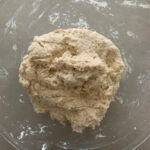
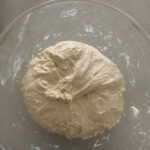
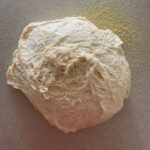
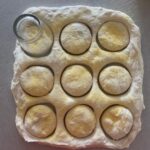

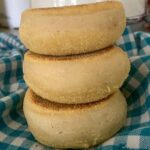

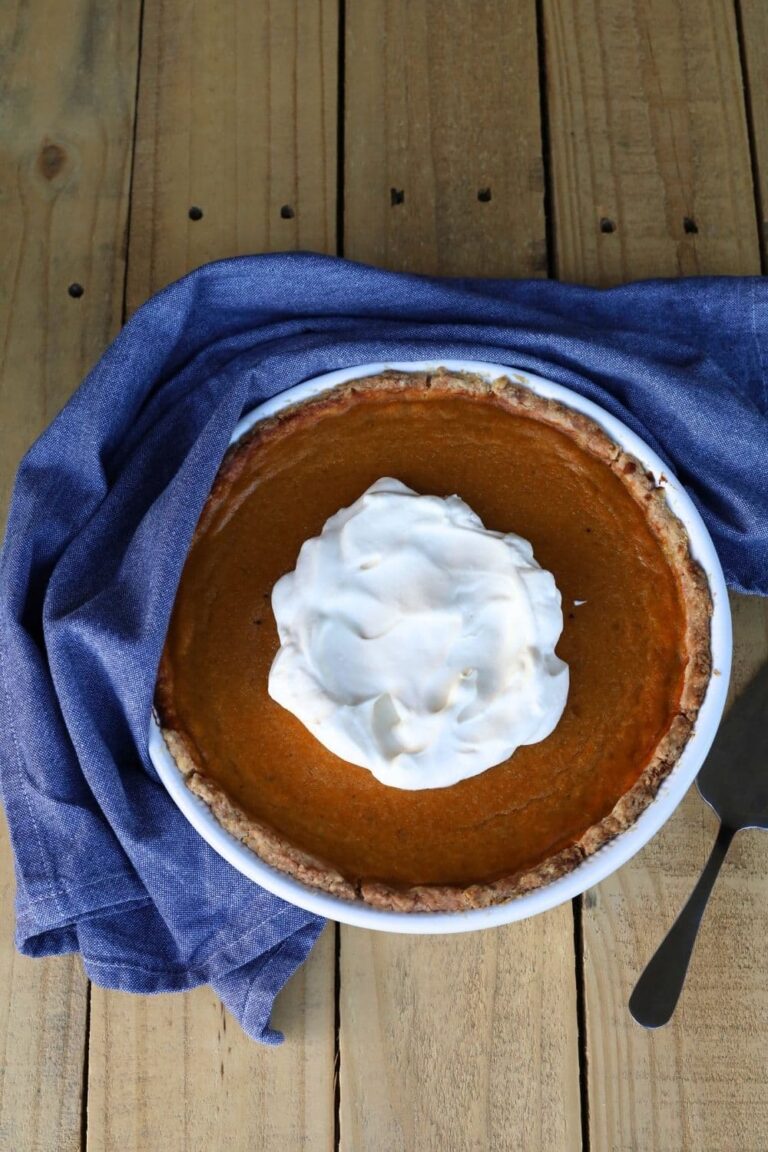
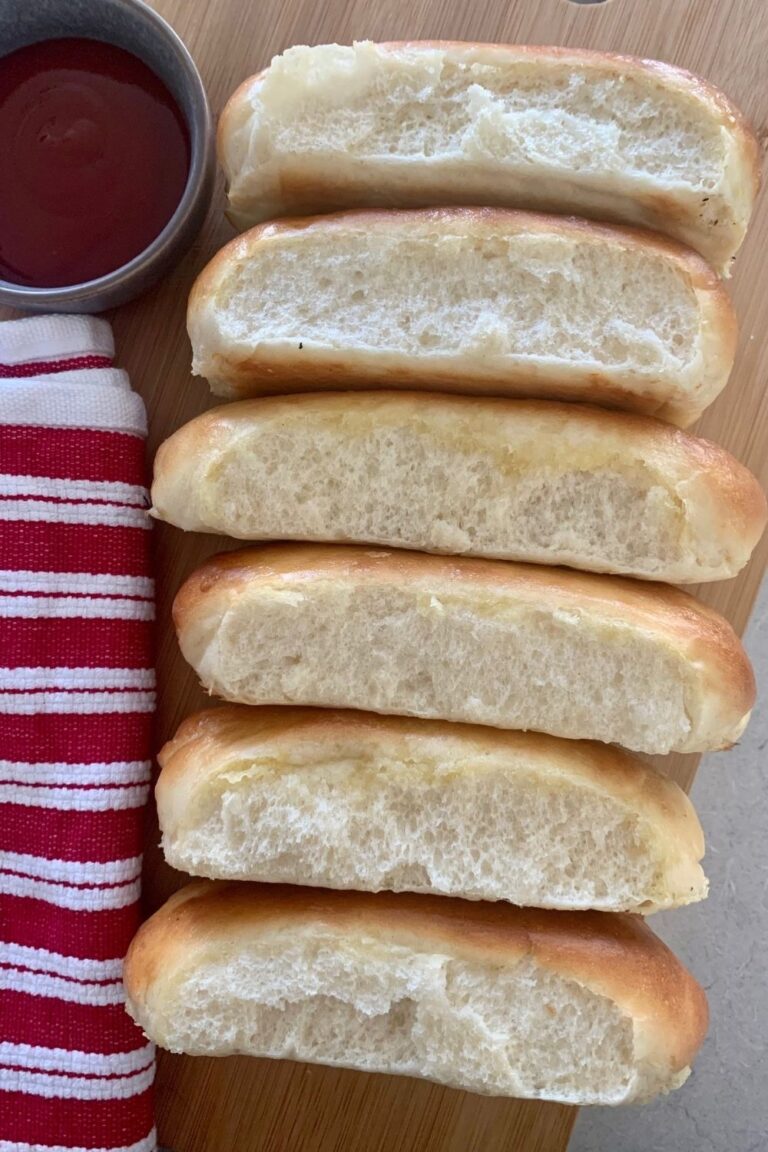
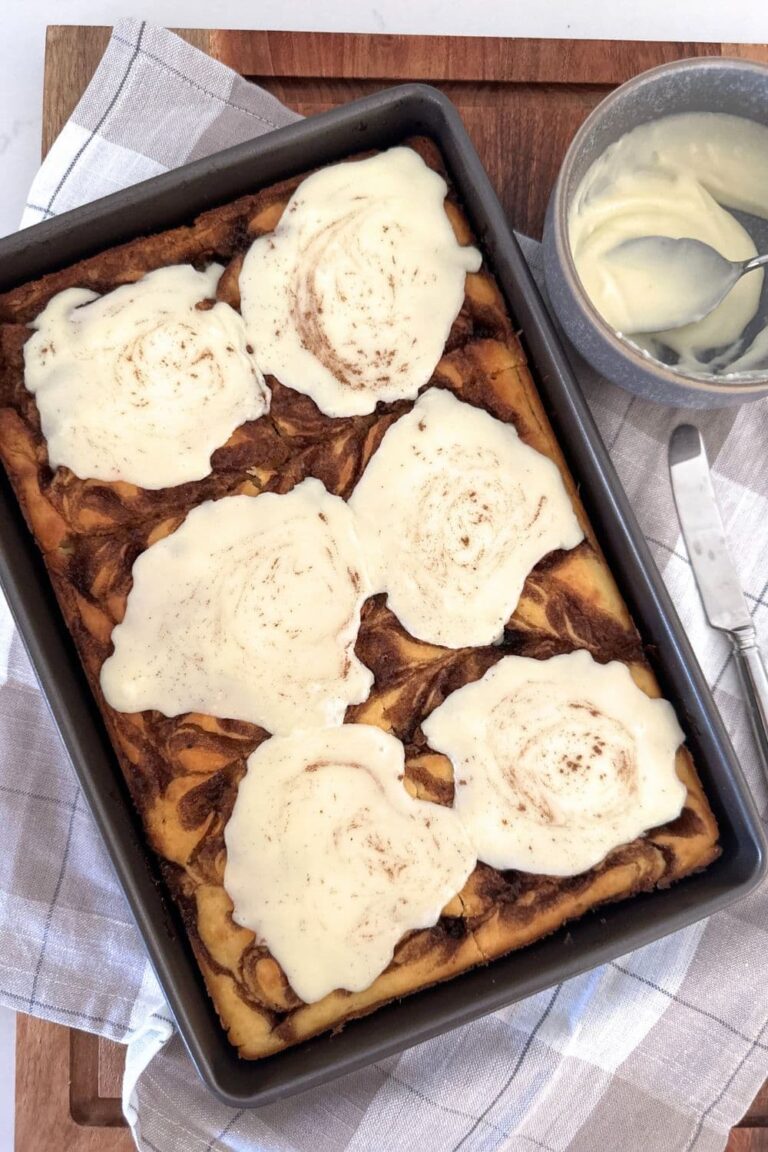

These were WONDERFUL and so easy! My only issue is with the browning of the muffins themselves. How do you keep the cornmeal from getting too dark and burning to the pan? I used an enamel cast iron on medium-high heat.
I'm so glad you love the recipe. Hmmmm I've never really had an issue with this but I would try to brush some of the cornmeal off before you add them to the pan 🙂
I was looking for a recipe that uses a lot of Discard 😞
Have you tried the discard crackers? We like those, and the pie dough, and the waffles (I think the no wait uses more)...and the tortillas, and sourdough noodles for starters. No pun intended. 😆🤣
While mine turned out ok, this recipe is ok, it’s far too moist and will be challenging for any beginner, I’m intermediate and it was a great exercise in extreme patience! From high hydration to sticking to the parchment, difficulty getting into the frying pan, it was very challenging.
Made these for the first time today, they are perfect! The taste is fabulous, will absolutely make these again. Made 22 muffins with this recipe, weren't as thick as the pictures from this recipe, but I don't mind! Thanks so much for sharing this!!
What is the shelf life of the cooked English Muffins and what is the best way to store without freezing?
They should last about 3-4 days in an airtight container at room temperature.
As a Brit living in England I find it odd that many recipes describe splitting muffins with a fork, which is something that almost no British people do. I either split them with a knife or with my hands. And nooks and crannies are much more associated with crumpets rather than muffins. Also of course here we just call them Muffins, they’re not exclusive to England, but common to the whole of the British Isles.
I love your recipes and I’m very happy to add this one to my regular bakes. I use the scrapings method so I never have discard to use up, these work really well with the usual bubbly starter.
Absolutely delicious! Followed your recipe to a tee and it worked out perfectly! Currently winter here in Australia so my house was nice and cold for the overnight ferment. I left it fermenting for around 14 hours then another hour after the stretch and folds. Will definitely make these again!
I never get 24 English muffins using that recipe more like 15
How big do you make yours?
It will depend on the size of the cutter you use as to how many you get. Sometimes I use a larger cutter and will only get 12 🙂
Can you substitute the milk with a vegan option such as almond, coconut, or oat milk?
You can! Any of those milks should work. 🙂
May I use home made cultured buttermilk instead of milk in this recipe? The buttermilk is a byproduct of making cultured butter.
Absolutely you can 🙂 I love cultured buttermilk and often have some from making my own cultured butter 🙂
Perfect recipe! These were so good they don’t taste like a long fermented sourdough at all so my picky kids also love them
Excellent recipe. I doubled it and fermented about 9 hours in oven with light on. S&F and into refrigerator for 1-1/2 days (it’s canning season).
Today cooking and they are wonderful.
Thank you for this recipe!
We eat store bought English muffins nearly every day.
OMG!
I made half the recipe for these and just finished cooking them. I split one and popped it the toaster before the second skillet full finished cooking.
SO GOOD!
I'm so glad you love this recipe! haha you'll never buy them again, so good! xo
Outstanding!!! I have made many batches of these English muffins and also modified to make cinnamon raisin and also cranberry orange versions. The recipe is very easy and works like a charm every time. My question is…how can I use this dough to make a loaf of bread? Thank you!!
I'm so glad you love this recipe Carolyn 🙂 You can use this sourdough English muffin loaf recipe to create a loaf from this recipe 🙂 Enjoy! xo
Great recipe! Can you advise on how to incorporate wheat flour?
You can use whole wheat in this recipe, but I would use only half whole wheat, half bread flour. Don't adjust the liquid amount, it should be ok 🙂
Do you need to cook in the skillet or can you bake them on a cookie sheet? What would be the oven temperature and time to bake? I don’t like the corn meal on my English muffins, is there a substitute for it not to stick? I love English muffins! This could save me so much money! Thank you for the recipe.
They are best when baked in a skillet yes, it's what gives them that delicious flavor where the outside has toasted on the hot skillet. If I was going to make them in the oven, I would bake them at 180ºC until they are golden and puffy, turning them to ensure the top and bottom are baked evenly. If you don't like cornmeal, you could use coarse semolina for the same effect without the flavor. Yes making your own English muffins is definitely a great way to save money 🙂 I hope you enjoy these 🙂
Made English muffins for the first time and they turned out pretty decent. The dough was super sticky though, maybe overproofed, after sitting overnight for just shy of 11 hours. I had a hard time rolling and cutting them out, despite using ample cornmeal. The edges after I cut them would try to squish out so I rolled them in corn meal as best I could. Ended up with some wonky rounds but they are edible and not too sour! I’ll try again, possibly reducing water a smidge and aiming for 10 hour overnight bulk. I also had to keep my stove temp switching from 4-5 to keep them from burning but still be hot enough, lol!
These are absolute perfection! We have made them three weeks in a row! My husband and 4yr old are obsessed with them! I grab a warm, buttered muffin on my way to work everyday too!
I'm not a novice sourdough baker, however I found the recipe to be a very high hydration and difficult to work with. It led me to calculate the total hydration including a 100 % hydration discard. 600g wet and 700g dry. This gives an 85.7% hydration dough. I added another 100g flour to drop it to 75% hydration. I'm guessing this will effect the quality of the nooks and crannies and I may be compelled to push that hydration up in my next attempt. That said, thank-you very much for posting this recipe. I'm looking forward to my homemade egg McMuffins tomorrow.
This recipe is absolute perfection! I’ve made it dozens of times overs the past year and it is always a crowd pleaser. Very forgiving as well, as I have used unfed and fed starter and still get a very tasty result. ALSO highly recommend this site in general for those of us new to using wild yeast.